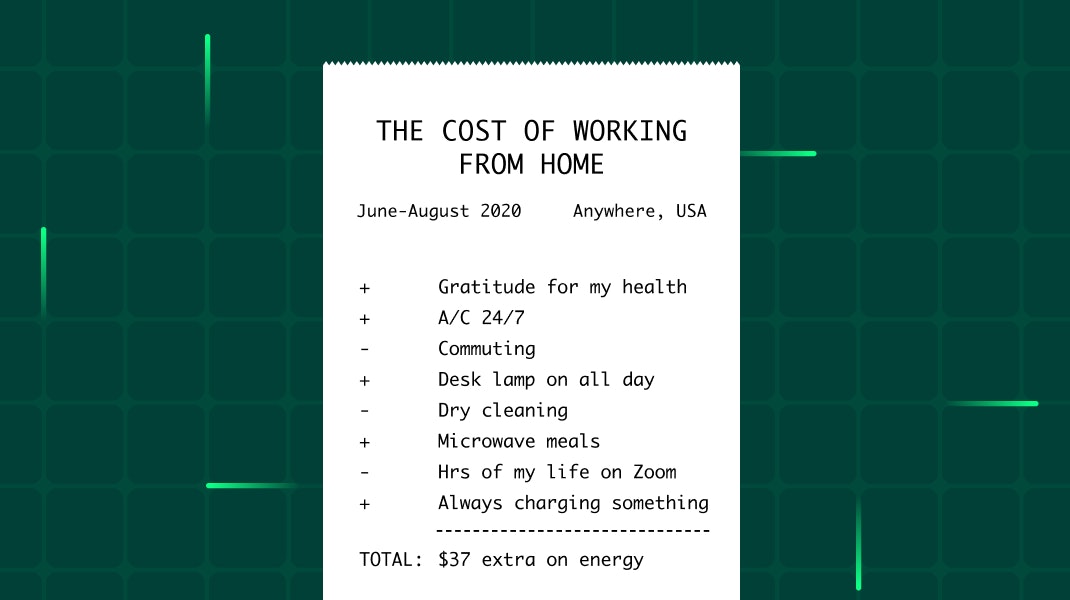The hidden energy costs of working from home

Even before COVID-19 turned living rooms across the country into home offices, remote work was becoming more and more popular. In 2018, 70% of businesses offered some form of telecommuting. And that trend is probably going to continue. A CreditCards.com survey found that 35% of employees surveyed want to continue working from home full-time after stay-at-home restrictions lift.
Working from home can be great — you have more flexibility, you don’t have to commute, you can work in your pajama pants and no one has to know. And because you’re saving on costs like gas, parking, and expensive cups of coffee, it might feel like remote work is cheaper than going into the office. But that may not be the case.
The average family of four will pay about $10 a month to keep all their screens lit as adults work remotely and kids take classes online.
Especially now that so much is online, you have to have quality, high-speed internet to keep everyone connected. That may mean upgrading and paying more for internet. The lack of catered lunches and free office snacks means that we’re spending more at the grocery store. You may be buying more of your own office supplies. But the biggest hidden cost to working from home may come on your energy bill.
It takes energy to stay connected and productive. Whether you’re using your computer more, streaming more television shows, or cranking your AC to stay cool, you’re probably using more energy than you were while working in an office. Utility companies in California, for instance, reported that residential electricity use has increased 15-20% in 2020 when everyone was stuck at home, and researchers at Columbia University found that New York City residents used 4-7% more electricity. That means higher electricity bills.
Severin Borenstein, an energy economist and director of the University of California Energy Institute, estimates that the average household could spend up to $5 a day, or around $100 a month, on additional energy use doing everything remotely. Our own research found that residents of major metro areas could expect to spend between $20 and $40 more on their monthly energy bills while working from home during the pandemic.
Where are the extra costs coming from? Here are some of the culprits:
Your air conditioning
Your HVAC is the biggest energy hog in your home and probably accounts for most of the increase in your power bill. It takes a lot of extra energy to keep your home comfortable during the day, especially during hot summers. To keep your bill spikes in check, try changing the filter on your AC, and use your window blinds and fans to your advantage. The cooler you can keep your home naturally, the less hard your air conditioning will have to work.
If you feel like you should be saving more money than you are while working remotely, take a look at your energy bill.
Your home office
The average family of four will pay about $10 a month to keep all their screens lit as adults work remotely and kids take classes online. Working remotely on a laptop computer takes about 53 kWh of electricity annually. If electricity costs $0.10/kWh, that’s $5.30. Desktop computers use more energy — about 275 kWh annually (at a cost of $27.50). That may not seem like much, but it can add up quickly when you factor in multiple devices being used for more hours in the day.
To make sure you’re using your home office equipment as efficiently as possible, unplug devices when you’re not using them. Your computer probably has built-in energy-efficiency settings that can help save you money, too.
Your entertainment center
Admit it: you’ve been binge-watching more television recently. We all have. And while that’s great for passing the time and keeping up with your coworkers, it does use energy. Watching a 65-inch Samsung television for five hours, for instance, will use about 0.36 kWh of energy. If we stick with our previous energy cost of $0.10/kWh, that’s an extra $0.03 on your bill for every marathon TV session.
If you feel like you should be saving more money than you are while working remotely, take a look at your energy bill. In some ways, employers are actually the ones benefiting from remote work; they’re saving on electricity, office supplies, food, and, in some cases, real estate. Some companies are even starting to look at new benefits to help employees cover the added costs of remote work, including subsidizing their energy bills. Interested? Send a message to your company to advocate for clean energy benefits while you’re working remotely.
Join our newsletter
Stay updated with our latest insights, industry trends, and expert tips delivered straight to your inbox


